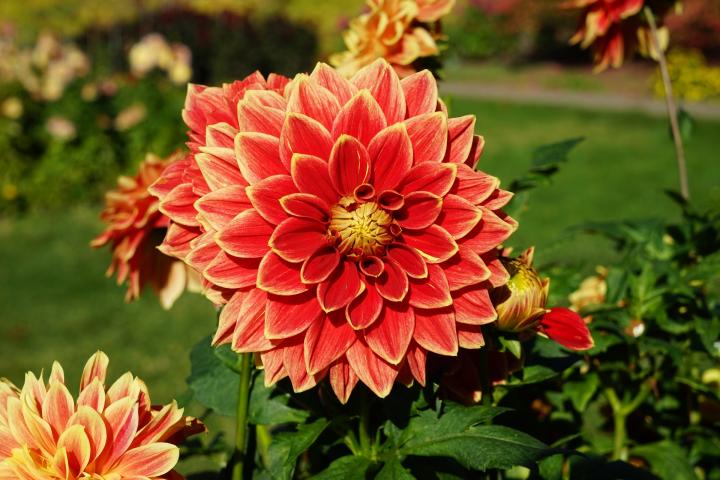Understanding the Ideal Climate for Dahlias
When it comes to planting dahlias, understanding the ideal climate and temperature is crucial for success. Dahlias are sensitive to temperature fluctuations, and planting at the right time can make all the difference. The ideal temperature range for planting dahlias is between 60°F to 75°F (15°C to 24°C), which typically occurs in the spring and early summer. However, it’s essential to wait until the soil has warmed up and the risk of frost has passed. To check if the soil is ready for planting, dig a small hole and fill it with water. If the water drains quickly, the soil is ready. If not, wait a few more days and try again. By understanding the ideal climate for dahlias, you can ensure a successful and thriving bloom.
How to Determine the Best Planting Time for Your Region
Determining the best planting time for dahlias depends on your location and climate. In general, dahlias thrive in regions with mild winters and cool summers. To determine the best planting time for your region, you need to check the last frost date. This date varies depending on your location, but it’s usually around late March to early May. Once you know the last frost date, you can plan to plant your dahlias about 2-4 weeks after. This allows the soil to warm up and the risk of frost to pass. Additionally, prepare the soil for planting by loosening it to a depth of 12-18 inches and adding organic matter such as compost or well-rotted manure. This will help improve drainage and provide nutrients for your dahlias. By understanding the best planting time for your region, you can ensure a successful and thriving bloom. When can you plant dahlias in your region? Check the last frost date and prepare the soil to get started.
The Role of Soil Temperature in Dahlia Planting
Soil temperature plays a crucial role in dahlia planting, as it directly affects the growth and development of the plants. Dahlias thrive in soil temperatures between 60°F to 70°F (15°C to 21°C), which is typically achieved when the air temperature is around 70°F to 80°F (21°C to 27°C). To check the soil temperature, you can use a soil thermometer or wait until the soil has warmed up naturally. If the soil is too cold, it can cause the tubers to rot, while soil that is too hot can lead to weak and leggy growth. To warm up the soil for optimal planting conditions, you can use black plastic mulch or row covers to trap the sun’s heat. Additionally, you can start dahlias indoors 4-6 weeks before the last frost date and then transplant them outside when the soil has warmed up. By understanding the importance of soil temperature, you can ensure a successful and thriving bloom. When can you plant dahlias in your region? Check the soil temperature and wait until it reaches the ideal range.
Spring vs. Fall Planting: Which is Best for Dahlias?
When it comes to planting dahlias, one of the most important decisions is whether to plant in the spring or fall. Both seasons have their pros and cons, and the best choice for you will depend on your specific climate and region. Spring planting is ideal for regions with mild winters and cool summers, as it allows the dahlias to establish themselves before the heat of summer. On the other hand, fall planting is better suited for regions with hot summers and mild winters, as it gives the dahlias a head start on the growing season. When can you plant dahlias in your region? Consider the climate and temperature to decide whether spring or fall planting is best for you.
In general, spring planting is recommended for dahlias, as it allows for a longer growing season and more blooms. However, fall planting can be beneficial in regions with hot summers, as it reduces the risk of heat stress and allows the dahlias to establish themselves before the winter. Ultimately, the decision between spring and fall planting comes down to your specific climate and region. By understanding the pros and cons of each, you can make an informed decision and get the most out of your dahlias.
Preparing Your Dahlias for Planting
Before planting dahlias, it’s essential to prepare the tubers properly to ensure a successful and thriving bloom. When can you plant dahlias in your region? Make sure to prepare your dahlias accordingly. In the fall, after the first frost, dig up the dahlia tubers and store them in a cool, dark place with good ventilation. Keep the tubers in a paper bag or cardboard box filled with vermiculite or peat moss to maintain humidity. Check on the tubers regularly to ensure they are not rotting or drying out.
In the spring, about 4-6 weeks before the last frost date, start preparing the dahlias for planting. Divide and replant the tubers, making sure each division has at least one “eye” or growing point. Allow the divisions to dry for a few hours to form a callus before planting. This will help prevent rot and ensure a healthy start. When planting, make sure the soil is warm and well-draining, and the tubers are planted at a depth of about 4-6 inches. By properly preparing your dahlias, you can ensure a strong and healthy start to the growing season.
Common Mistakes to Avoid When Planting Dahlias
When it comes to planting dahlias, there are several common mistakes to avoid to ensure a successful and thriving bloom. One of the most critical mistakes is planting too early or too late. When can you plant dahlias in your region? Make sure to check the last frost date and wait until the soil has warmed up to at least 60°F (15°C) before planting. Planting too early can expose the tubers to frost, while planting too late can reduce the growing season.
Another common mistake is not preparing the soil properly. Dahlias require well-draining soil with a pH between 6.0 and 7.0. Failure to prepare the soil can lead to rot and poor growth. Additionally, not providing enough support for the plants can cause them to topple over in the wind. Make sure to provide stakes or a trellis for tall varieties to ensure they grow upright and strong.
Other mistakes to avoid include not dividing and replanting the tubers regularly, which can lead to a decrease in bloom quality and quantity. Failing to deadhead the flowers can also reduce the number of blooms and encourage the plant to focus its energy on seed production rather than blooming. By avoiding these common mistakes, you can ensure a successful and thriving dahlia bloom.
Tips for Successful Dahlia Planting
To ensure a successful and thriving dahlia bloom, it’s essential to follow some additional tips and advice. When can you plant dahlias in your region? Make sure to space the plants correctly, about 12-18 inches apart, to allow for good air circulation and sunlight penetration. Water the plants regularly, but avoid overwatering, which can lead to root rot. Fertilize the dahlias regularly, using a balanced fertilizer, to promote healthy growth and blooming.
Provide support for tall varieties, using stakes or a trellis, to keep them upright and strong. Mulch around the base of the plants to retain moisture, suppress weeds, and regulate soil temperature. Keep the area around the plants weed-free to prevent competition for nutrients and water. By following these tips, you can ensure a successful and thriving dahlia bloom.
Additionally, consider the specific growing conditions required by the dahlia variety you are planting. Some dahlias require more sunlight or shade, while others may need more frequent watering. Research the specific needs of your dahlia variety to ensure optimal growing conditions. By following these tips and advice, you can enjoy a beautiful and thriving dahlia bloom throughout the growing season.
Getting the Most Out of Your Dahlias
To get the most out of your dahlias, it’s essential to provide regular maintenance and care throughout the growing season. Deadheading, or removing spent blooms, is crucial to encourage the plant to produce more flowers. Simply snip off the faded blooms, and the plant will redirect its energy to producing new flowers. This will ensure a continuous display of beautiful blooms throughout the summer.
Staking is also crucial for tall dahlia varieties to prevent them from toppling over in the wind. Use stakes or a trellis to provide support, and tie the stems gently but securely to the stake. This will keep the plant upright and promote healthy growth. Additionally, consider providing a layer of mulch around the base of the plants to retain moisture, suppress weeds, and regulate soil temperature.
When can you plant dahlias in your region? By following these tips and advice, you can enjoy a beautiful and thriving dahlia bloom throughout the growing season. With proper care and maintenance, dahlias can provide a stunning display of color and beauty in any garden or landscape. By understanding the ideal climate and temperature for dahlias, determining the best planting time, and providing regular care and maintenance, you can get the most out of your dahlias and enjoy their beauty for months to come.








